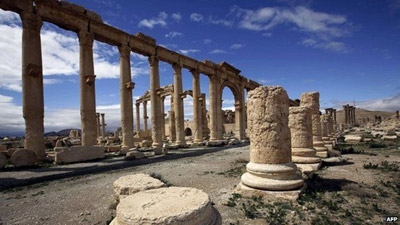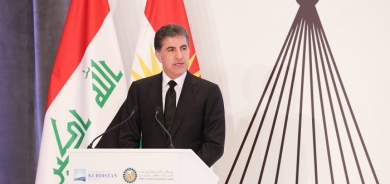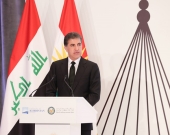Islamic State seizes Syria's ancient Palmyra

Unesco says its destruction would be "an enormous loss to humanity", but no damage has been reported there yet.
IS now controls the nearby airport, prison and intelligence HQ, the Syrian Observatory for Human Rights says.
The militants have previously demolished ancient sites in Iraq that pre-date Islam.
The BBC's Jim Muir in Beirut says acute international concern over Palmyra might actually spur the jihadists on to make destroying the site a priority.
The ancient ruins are situated in a strategically important area on the road between the Syrian capital, Damascus, and the contested eastern city of Deir al-Zour.
Palmyra is also close to oil and gas fields.
Elsewhere in Syria, 40 rebels from Islamist factions were killed in Aleppo when government forces bombed a rebel headquarters, the Syrian Observatory for Human Rights said.
The oasis city of Palmyra lies on a strategic route through the desert
Loudspeakers
An activist who has family members in Palmyra told the BBC that his relatives wanted to flee but there was no way out.
IS fighters were searching the city for Syrian army soldiers, he said, and residents were being warned via mosque loudspeakers not to hide them.
He also said the inhabitants were angry that Western media are focusing on the ancient ruins, and not the population.
"We still don't have accurate figures about how many civilians there are in Palmyra but there are plenty," he said.
"People think the West cares more about the civilisation than about the people who created or initiated this civilisation."
Tadmur, the Arabic name for the modern settlement next to Palmyra, would normally have a population of around 70,000, but it has recently been swollen by an influx of people displaced from other combat areas.
Syrian state media said pro-government forces had pulled out after "assuring the evacuation" of "most" of its inhabitants.
Talal Barazi, the Governor of Homs Province, which includes Palmyra, told the Associated Press that 1,300 people had fled the city over the past few days, and more were trying to leave.
Palmyra rose to prominence under the Romans but its rulers later created a rival empire of their own
Hundreds of artefacts from Palmyra have been taken to Damascus, Syrian authorities say
Saving history from the jihadists
Rising out of the desert, the site contains the monumental ruins of a great city, which Unesco and others consider one of the most important cultural centres of the ancient world.
Dating back to the 1st and 2nd Century, when the region was under Roman rule, Palmyra is dominated by a grand, colonnaded street.
The Syrian Observatory reported that more than 100 pro-government troops were killed in overnight clashes around Palmyra.
A researcher from the monitoring group also told the BBC on Friday that IS now controls more than half of Syrian territory.
However, the BBC's Arab Affairs Editor Sebastian Usher says this figure may give a false impression because there are large areas to the east under IS control that are not very significant strategically.
BBC













